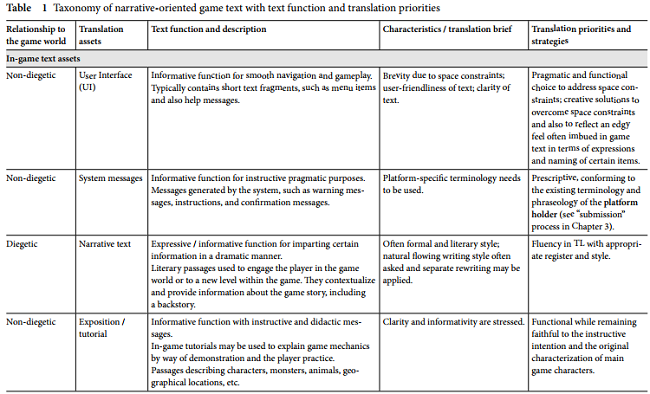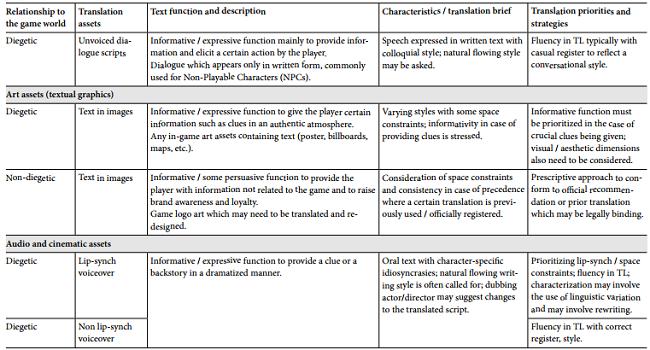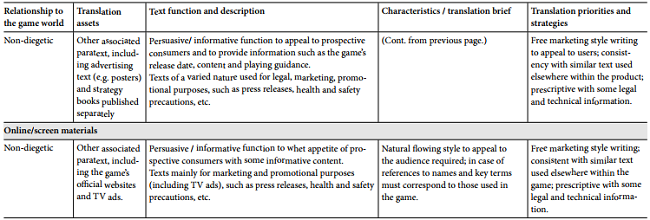- 签证留学 |
- 笔译 |
- 口译
- 求职 |
- 日/韩语 |
- 德语
Here, Table1 provides a working taxonomy of a story-oriented console game text which we use to highlight text function, linking it in turn to translation priorities analyzed from a functionalist perspective. In considering each key game asset from the interest of its function, we apply functional characteristics of text types discussed by Katharina Reiss (1971/2000, 24-47): content-focused texts, where the informative function is stressed; form-focused texts with the expressive function as the main, and appeal-focused texts with the persuasive function. Reiss gives examples for each text type, such as commercial correspondence or operating instructions for informative text, literary prose of different kinds as expressive text, and advertising and publicity as persuasive text. She discusses "audio-medial text" as the fourth text type which incorporates technical media and graphic, acoustic, and visual expressions, which in turn can be categorized according to the above three text types but with additional considerations. Although we primarily adopt a TT-oriented perspective in considering translation, Reiss's text categorization based on ST-function is still relevant as game localization is required to largely retain the function of the original game assets. We refer to the labels given to the three main functions of informative, expressive, and persuasive in our text type analysis shown in Table 4.1. Reiss's work has come in for some criticism from theorists (see Munday 2001, 76 for a summary), especially for its rigidity in associating language functions with text types; however, we will not focus on language functions but rather on considering translation priorities and strategies, drawing on Nord's refinement of Reiss's work (Nord 1997, 2005), moving to focus more on the function of the TT from a Skopos Theory perspective (Vermeer 1989/2000). According to Nord (1997) a “translation brief" which constitutes specifications for translation given by the translation commissioner takes precedence and shapes translation priorities and strategies.
In the case of game localization, a localization kit (see 3.4.1) is ideally designed to provide such detailed specifications, guiding the ensuing process. Our working game text taxonomy presented in Table 1 indicates key assets according to well-established industry categorization of in-game text assets, art, audio, and cinema assets and printed materials. We have further added other online/screen materials which form wider paratext. The first column indicates whether or not the given translation asset is considered to be directly part of the game world (i.e. diegetic or non-diegetic). The remaining columns are arranged in order of translation asset, its text function and description, characteristics of the text when translating and also based on likely instructions given by the commissioner, and finally typical translation priorities and strategies expected of the given asset.
Certain genres such as adventure games and RPGs, which may be either console-based or online, will typically have a high volume of text for translation, with their heavy reliance on "telling a story through character dialogue, in-game cut scenes, and books, notes, or other props found in the game world" (Chandler 2005, 139-140). Furthermore, a wide range of text types, from literary to technical with the use of literary narrative devices, legal text and contemporary dialogue scripts full of street-speak, can be present within one game. Such characteristics of game texts make the streamlined standardization approach common in productivity software localization often unworkable (Darolle 2004).




Each title requires a different translation approach in relation to the unique features of the game (Chandler 2008a, 37). That said, knowing the most typical taxonomies of game text can facilitate the selection of more appropriate translation strategies which minimize the risk of translation errors, especially when working under time pressure with insufficient context. In the following section we discuss each text-asset shown in Table 1 in some detail.
责任编辑:admin
